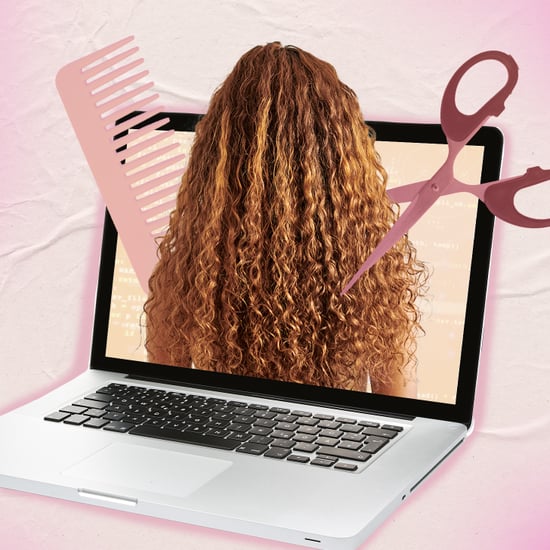Virtual Reality Being Used as Pain Relief During Injectables
How a Cosmetic Doctor Is Using Virtual Reality For Pain Relief During Injectable Treatments

When you think about virtual reality (VR), we're pretty sure you think gaming and, well, gaming. The last place you'd expect to find a VR headset is at a skin-care clinic, but that's exactly what you'll discover Dr Sophie Shotter — cosmetic doctor, founder of Illuminate Skin Clinic in Kent, and former anaesthetist — using these days as she administers lip filler and hair-growth treatments. And yes, she has a medical reason for doing so.
If you're not familiar with VR, essentially, it's a three-dimensional, computer-generated simulation that someone can explore and interact with by wearing a headset and using a hand-controlled remote. VR headsets were first released in the '90s, but it was really 2010 onwards when the next generation of the technology really caught on.
Since 2010, the headsets have mostly been used by avid gamers, but more recently, there's been a spotlight on their many other uses — one being pain reduction. Yep, virtual reality has been proven to be effective, drug-free pain relief. Whilst VR has been used in a dental setting for some time, it's still not commonplace. Dr Shotter is at the forefront of proving how well it works in a clinical setting for multiple different treatments and procedures. "I saw a potential for use of this technology within the aesthetic arena," she told POPSUGAR. "The Oculus is the leading VR headset in the market to date, with various options of programmes for pain reduction."
A study from Cedars-Sinai Medical Center in New York City and published in the PLOS ONE journal in August 2019 supports the idea of VR as effective pain relief. "Virtual reality significantly reduces pain and is most effective for severe pain," the results found. Whilst researchers don't know exactly why it works so well, it's thought that the success is heavily due to "The Gate Control Theory of Pain," which theorises that nonpainful sensations can override painful sensations. In this instance, the calming sensations caused by the virtual-reality program can override or reduce those painful sensations caused by a procedure.
"[VR] actually helps block pain signals from reaching the brain, significantly reducing drug requirement," Dr Shotter said.
After hearing about and researching VR's efficacy at providing pain relief, it wasn't long before Dr Shotter started to experiment with it in her practice, most notably whilst administering scalp treatments and lip fillers (VR works particularly well during lip injectable treatments as we have a lot of nerves in our lips). "First, I tried treating my receptionist who has had lip injectables done a couple of times before. Every time, she found it really painful. She'd put the numbing cream on about an hour before, reapply the cream, and she'd still find it painful." When given the Oculus VR headset, however, the receptionist barely noticed that Dr Shotter had completed the procedure. "It just didn't bother her; she was lying there completely unflinching." Whilst interviewing Dr Shotter, she showed me a video of the procedure she was referring to, and it was clear that the use of VR was transformative for the patient. She was astonished and said she could feel the needle going into her lips but noted not caring about it and not feeling the pain from it.
In addition to lip injectables, Dr Shotter has tried VR on patients during microneedling, ultherapy, and scalp treatments. "I treated a man for hair loss who was on his final treatment out of five, which he rated his pain as being an 8/10. When we did the final treatment using the VR headset, his pain was a 2/10," she explained. Not only that, but Dr Shotter also noticed that he wasn't bleeding in a way that he normally does. "Because he was less stressed and had less pain, his blood pressure was lower and therefore he wasn't bleeding as much."
This helps support the notion that VR may have the potential to do more than distracting the mind from the pain; "it actually helps block pain signals from reaching the brain, significantly reducing drug requirement," Dr Shotter explained.
She also treats patients who don't necessarily experience pain during their treatment but may be a little nervous or uneasy. Dr Shotter noted that it really helps calm down any nerves or takes the edge off during the treatment, thanks to the VR's relaxing programs such as guided meditation in a beach setting.
Obviously, VR s still very much in the beginning stages of pain reduction in clinics and isn't yet commonplace. Why? Because it's not all that cheap and has limitations due to the size of the headset. It's big, it's clunky, and it covers a large area of the face. That's why it works well for some treatments like lip injectables and scalp procedures but not others where going near the eye or forehead area is required.
I tried the headset on myself (however, not during a treatment, so can't comment on pain relief from personal experience), and although it wasn't my first time trying VR, I was taken back by how instantly relaxing it is. Despite the current limitations to it, it is a fascinating concept and could be truly game-changing in the medical landscape in years to come. Highly trained doctors like Dr Shotter using VR headsets in clinics are helping to not only reduce patient pain but also help to realise the potential this technology has in many other medical fields.







